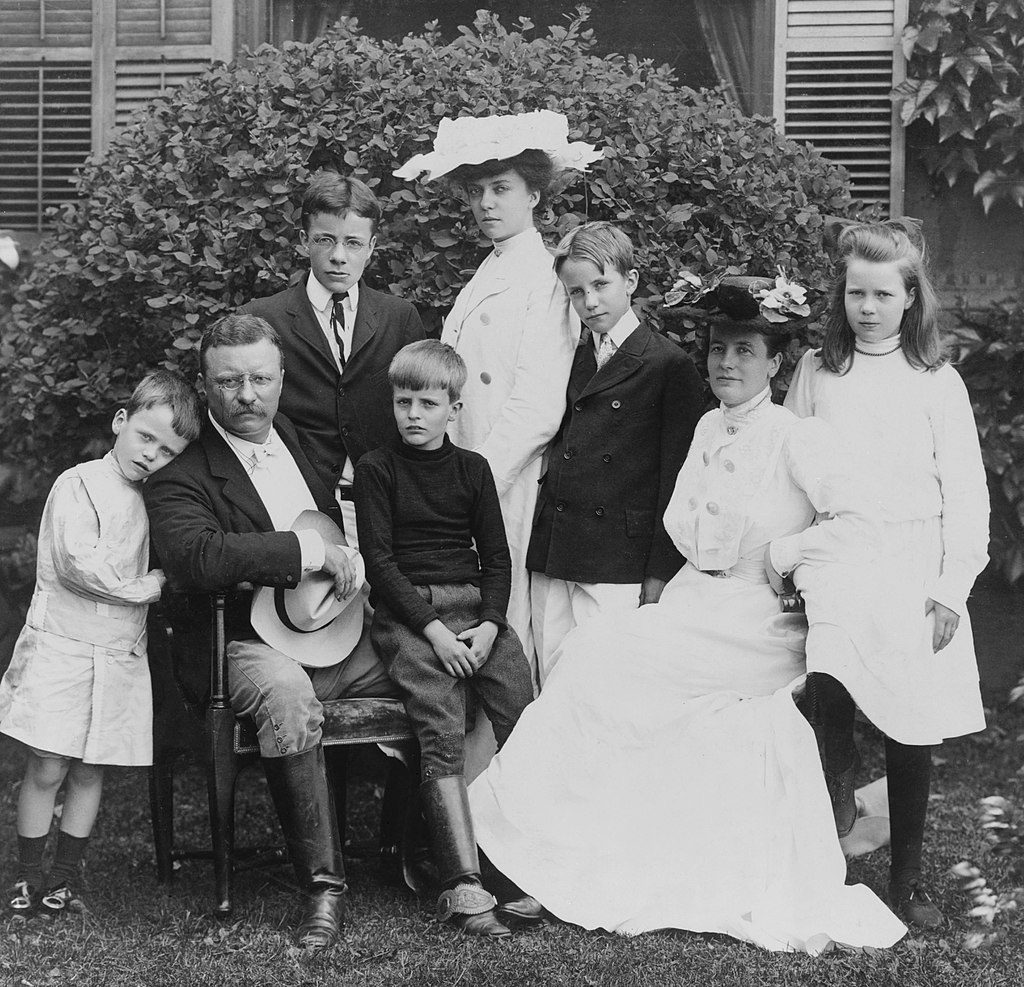Born August 6, 1861, in Norwich, Connecticut, Edith Carow would become the second wife of the nation’s future U.S. President, Theodore Roosevelt. Roosevelt had been married once before, in his early twenties, to Alice Hathaway Lee. Alice, unfortunately, died a day after giving birth to her only child, and after only four years of marriage to Theodore. She was twenty-two at the time and was later determined to have undiagnosed kidney disease, which was masked by the symptoms of her pregnancy.
Theodore sent their baby, a daughter named Alice after her mother, to live with his sister, Anna. By the time young Alice was three years old, Theodore had remarried to Edith, and he and Edith took back custody of Alice to themselves. However, Alice was a headstrong young woman, and whenever she proved to be too much for Theodore and Edith to handle, they would send her back to spend more time with the older and stricter Alice.
Edith, who would one day be tasked with helping raise the independent and sometimes purposefully scandalous Alice, was the daughter of Charles Carow and Gertrude Elizabeth Tyler. Her father was a merchant, and her grandfather on her mother’s side was a Union general in the Civil War. She had a younger sister and an older brother. Early in her childhood, her parents moved to New York City, and her next-door neighbors as a child were the Roosevelt family, which included her future husband, Theodore. In fact, Theodore’s younger sister, Corinne, was Edith’s childhood and lifelong best friend.
Edith even had her earliest schooling with the Roosevelt children at their home, and later attended Miss Comstock’s finishing school. She and Theodore had a romance together as teenagers, but they drifted apart when he went away to attend Harvard. Harvard is where he met his first wife, Alice, and Edith attended their wedding.
After Alice’s death, Theodore refused to speak of her, and burned much of their correspondence to each other, and even tore out pages in his diary that mentioned her; he did not even mention her in his autobiography. This was frustrating to his daughter with Alice, who wanted more information on her mother. Edith, who knew Alice personally, once told her step-daughter that Alice was beautiful but insipid and a childlike fool, and that had she lived, she likely would have bored Theodore to death with her dimwittedness. This, naturally, did not endear Edith anymore to her step-daughter.
Edith and Theodore began their romance anew the year after Alice’s death, and married the year after that, on December 2, 1886. After marrying, they lived on Sagamore Hill in Long Island, New York. Together, Edith and Theodore had five children… four sons and one daughter. With the addition of young Alice from Theodore’s first marriage, this made six children in the Roosevelt household.
Theodore was appointed to the US Civil Service Commission in 1888, which required him to move to Washington, D.C. It was a move Edith supported and was only disappointed that her third pregnancy with their son, Kermit, kept her in Long Island longer than she wanted to be. In 1894, Theodore was going to run for mayor of New York City, but did not at Edith’s insistence, as she preferred living in Washington, D.C.
However, when Theodore’s federal appointment came to an end in 1895, he became the New York City Police Commissioner, and the family moved back to NYC. However, Theodore was appointed as Assistant Secretary of the Navy two years later, and the family was once again living in the nation’s capital. The next year, Edith went with Theodore by train to Tampa, Florida, to see him off as he went to fight in the Spanish-American War.

Pres. and Mrs. Theodore Roosevelt seated on lawn, surrounded by their family; 1903. From left to right: Quentin, Theodore Sr., Theodore Jr., Archie, Alice, Kermit, Edith, and Ethel. (Wikipedia)
He returned later that year and was nominated for governor of New York, which he won, and Edith became First Lady of New York. While in this position, she modernized the governor’s mansion and answered Theodore’s mail. She also began a tradition she continued as First Lady of the United States… holding a bouquet of flowers in each hand when greeting guests. She disliked shaking hands, as she found it too familiar. She preferred to bow her head instead, and having flowers in each hand gave her the excuse to do it.
Two years later, Theodore became Vice-President of the United States, and the family went to the nation’s capital once more. The following year, President McKinley was assassinated, and Theodore became President. There was a period of national mourning right after Theodore took office, where Edith could do no entertaining. She spent this time trying to fit her large brood of children into the White House. In doing so she eliminated the White House housekeeper’s position, taking on these duties herself, to conserve space and money.
Edith later hired a full-time social secretary and was the 1st First Lady to do so. The secretary was initially hired to help plan Edith’s step daughter’s official social debut, but Edith began to rely on her more and more to help her manage the First Family’s household. This included releasing official family pictures to the press to avoid unauthorized ones from making their way into newspapers and magazines.
As First Lady, Edith increased the number of social events at the White House, made sure her parties were fancier than those of other Washington political wives and worked to make Washington the nation’s cultural as well as political capital.
Edith also oversaw extensive White House renovations, which included the separation of public and family quarters, and resulted in the creation of the West Wing (which was for political use, while the East Wing was for family only). During this time, the White House became officially known as the White House; it had previously been called the Executive Mansion.
After leaving the White House, Edith and Theodore traveled with their children to every continent except Australia and Antarctica. They helped on the home front during WWI. Edith encouraged women to vote after the 19th Amendment giving them that right passed in 1920.
Shortly before she died, Edith destroyed all of her correspondence with Theodore, a common practice for the past two or three centuries. However, she was a prolific letter writer, and copies of most of the letters she destroyed already existed in various repositories around the country. She did not destroy letters written to people other than her husband. These letters were also saved in archives.
Edith died September 30, 1948, at 87 years old and was buried next to Theodore, who had died in 1919, at Youngs Memorial Cemetery in Oyster Bay, New York, about a mile and a half from their home on Sagamore Hill on Long Island.




